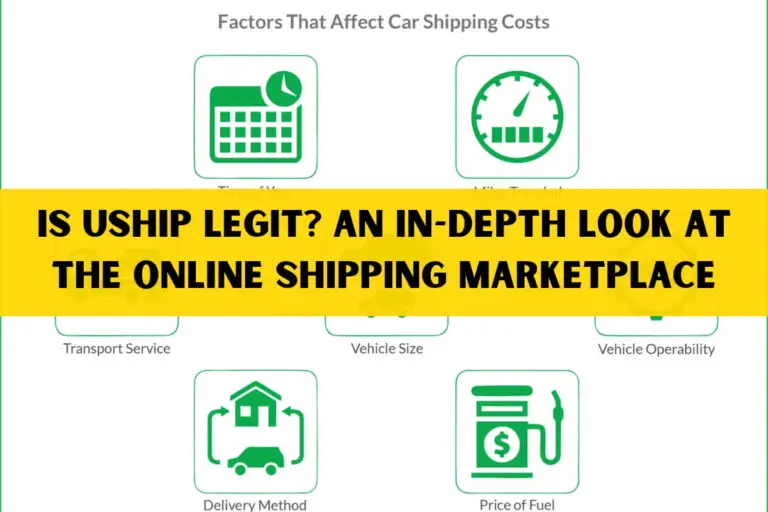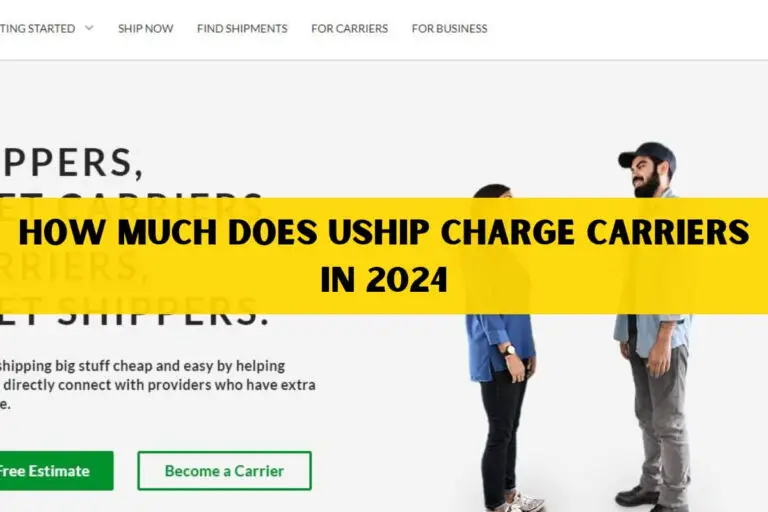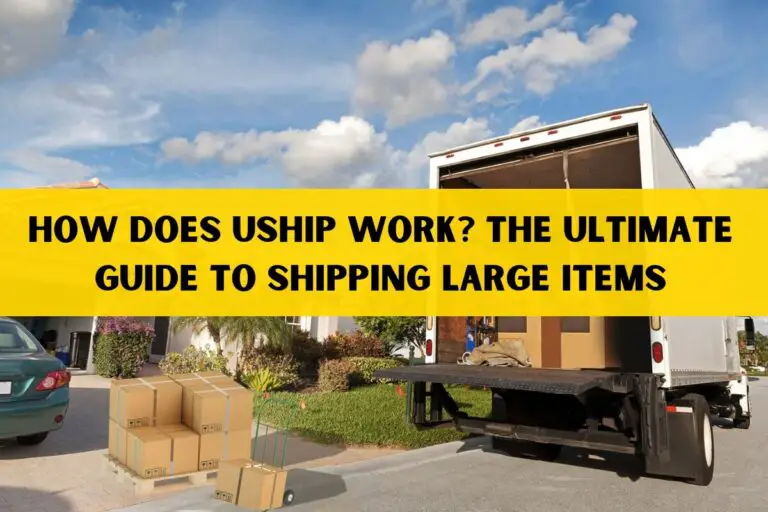How to Become a Carrier for uShip: A Comprehensive Guide

uShip is an online shipping marketplace that connects people and businesses with customer-rated carriers for transporting goods of all kinds. If you’re interested in becoming a uShip carrier, you’re entering a flexible and potentially lucrative industry.
To get started, you’ll need to meet certain requirements, create an account, set up your profile, bid on shipments, and comply with regulations. This guide will explain the process of becoming a uShip carrier, covering the necessary steps and qualifications:
- Understanding uShip and Its Role in the Transportation Industry
- Requirements for Becoming a uShip Carrier
- Step-by-Step Guide to Creating a uShip Account and Profile
- Bidding Strategies and Tips for Winning Shipments
- Compliance and Legal Considerations
- Best Practices for Successful uShip Carriers
- Frequently Asked Questions (FAQs)
Whether you’re a seasoned professional or new to the transportation industry, this guide will provide you with the knowledge and insights you need to navigate the process of becoming a uShip carrier with confidence.
1. Understanding uShip and Its Role in the Transportation Industry
Before we delve into the specifics of becoming a uShip carrier, it’s essential to understand the platform and its significance in the transportation industry. uShip is an online shipping marketplace that connects people who need to transport goods with customer-reviewed carriers who can handle those shipments.
Unlike traditional shipping methods, uShip operates on a bidding system. Shippers list their items and shipment details, and carriers then bid on the job, allowing shippers to compare prices and choose the carrier that best suits their needs. This innovative approach has revolutionized the way goods are transported, providing shippers with a wider range of options and carriers with access to a vast pool of potential jobs.
uShip has gained popularity due to its ability to facilitate the transportation of a wide range of items, from vehicles and heavy equipment to household goods and even pets. By leveraging the power of the internet and customer reviews, uShip has created a transparent and trustworthy platform that benefits both shippers and carriers.
2. Requirements for Becoming a uShip Carrier
Before you can start bidding on shipments through uShip, you’ll need to meet certain requirements. These requirements are in place to ensure the safety and reliability of the platform for both shippers and carriers.
Basic Requirements:
- Age Requirement: You must be at least 21 years old to become a uShip carrier.
- Valid Driver’s License: You’ll need a valid driver’s license to operate the vehicle you’ll be using for transportation.
- Reliable Vehicle: While there are no specific vehicle requirements, you’ll need access to a reliable and well-maintained vehicle capable of transporting the types of shipments you plan to handle.
- Smartphone: A smartphone compatible with the uShip driver app is required to manage your shipments and communicate with shippers.
Additional Requirements:
- DOT Number: If you plan to transport goods across state lines, you’ll need a U.S. Department of Transportation (DOT) number.
- MC Number: Carriers operating as a business or transporting certain types of goods may need to obtain a Motor Carrier (MC) number from the Federal Motor Carrier Safety Administration (FMCSA).
- Insurance: While not explicitly required by uShip, it’s highly recommended that you carry liability and cargo insurance to protect yourself, your vehicle, and the shipments you transport.
Requirements may vary depending on shipment type and local regulations. Research and comply with all applicable laws and regulations.
3. Step-by-Step Guide to Creating a uShip Account and Profile
Now that you understand the requirements, it’s time to create your uShip account and set up your carrier profile. Here’s a step-by-step guide to get you started:
- Go to uShip.com and click on the “Carriers” tab: This will take you to the page where you can create your account.
- Fill out the registration form: Provide your basic information, such as your name, contact details, and the type of vehicle you’ll be using for shipments.
- Complete the application process: uShip will guide you through the remaining steps, which may include providing additional documentation or information, depending on your specific situation.
- Set up your carrier profile: Once your account is approved, you’ll need to create a detailed profile that showcases your services, equipment, and experience. This is your chance to stand out and attract potential shippers.
- Profile Picture: Include a clear and professional photo of yourself or your company logo.
- About Section: Provide a detailed description of your services, areas of expertise, and any relevant certifications or qualifications.
- Vehicle Information: List the details of the vehicle(s) you’ll be using for shipments, including the make, model, year, and any special features or equipment.
- Service Areas: Specify the areas or routes you’re willing to cover, as well as any limitations or restrictions.
- Rates and Pricing: Clearly outline your pricing structure and any additional fees or charges.
- Reviews and Ratings: Encourage satisfied customers to leave positive reviews and ratings, as these will help you stand out in the uShip marketplace.
Remember, your profile is your virtual storefront, so take the time to make it as comprehensive and appealing as possible.
4. Bidding Strategies and Tips for Winning Shipments
Once your account and profile are set up, you’re ready to start bidding on shipments through uShip. However, winning shipments in this competitive marketplace requires a strategic approach and a deep understanding of the bidding process.
Understanding the Bidding Process:
- Browse Available Shipments: Use the uShip load board to search for shipments that match your capabilities and preferences.
- Review Shipment Details: Carefully review the shipment details, including the pickup and delivery locations, dimensions, weight, and any special requirements.
- Submit Your Bid: Based on the shipment details and your costs, submit a competitive bid that balances profitability and attractiveness to the shipper.
- Monitor and Respond: Keep an eye on your bids and be prepared to respond promptly to any questions or requests for clarification from shippers.
- Accept or Decline: If your bid is accepted, review the details carefully and accept the shipment if you’re confident you can fulfill the requirements.
Bidding Strategies and Tips:
- Analyze Competitor Bids: Monitor the bids of other carriers to get a better understanding of the market rates and adjust your pricing accordingly.
- Consider All Costs: Factor in all associated costs, such as fuel, tolls, labor, and any additional fees or charges.
- Highlight Your Strengths: In your bid, emphasize your experience, reliability, and any unique selling points that set you apart from competitors.
- Respond Promptly: Shippers often prefer carriers who are responsive and communicate effectively, so make sure to respond to inquiries and messages promptly.
- Build Relationships: Treat each shipment as an opportunity to build a lasting relationship with the shipper, which could lead to future business.
Winning shipments on uShip requires more than just a low price. It’s about showing professionalism, reliability, and a commitment to great service.
5. Compliance and Legal Considerations
As a uShip carrier, it’s crucial to understand and comply with all relevant laws and regulations governing the transportation industry. Failure to do so can result in fines, penalties, or even the revocation of your operating authority.
Key Legal Considerations:
- DOT Compliance: If you’re transporting goods across state lines, you’ll need to comply with DOT regulations, including maintaining accurate logs, adhering to hours-of-service rules, and undergoing periodic vehicle inspections.
- FMCSA Regulations: The Federal Motor Carrier Safety Administration (FMCSA) oversees the transportation of certain types of goods, such as hazardous materials or passengers. You may need to obtain additional certifications or comply with specific regulations depending on the nature of your shipments.
- State and Local Laws: Be aware of any state or local laws that may apply to your operations, such as licensing requirements, weight restrictions, or route limitations.
- Insurance Requirements: While not explicitly required by uShip, it’s highly recommended that you carry adequate insurance coverage to protect yourself, your vehicle, and the shipments you transport. Many shippers may not work with carriers who lack proper insurance.
- Liability Insurance: This coverage protects you in case of accidents or incidents that result in bodily injury or property damage to third parties.
- Cargo Insurance: Also known as freight insurance, this coverage protects the shipments you’re transporting in case of loss, damage, or theft during transit.
Maintaining proper insurance not only protects your business but also demonstrates your professionalism and commitment to providing safe and reliable transportation services.
6. Best Practices for Successful uShip Carriers
Becoming a successful uShip carrier involves more than just meeting the basic requirements and winning shipments. To truly thrive in this competitive marketplace, it’s essential to adopt best practices that set you apart from the competition.
Communication and Customer Service:
- Respond Promptly: Shippers value carriers who are responsive and communicate effectively. Make it a priority to respond to inquiries and messages promptly.
- Provide Regular Updates: Keep shippers informed about the status of their shipments, including any delays, changes, or issues that may arise during transit.
- Be Professional and Courteous: Treat every shipper with respect and professionalism, regardless of the size or complexity of the shipment.
Operational Efficiency:
- Plan Routes Effectively: Utilize routing software or tools to plan the most efficient routes, taking into account factors such as traffic, road conditions, and delivery schedules.
- Maintain Your Vehicle: Regular maintenance and inspections can help prevent breakdowns and ensure your vehicle is in top operating condition.
- Optimize Loading and Unloading: Develop efficient loading and unloading procedures to minimize the time spent at pickup and delivery locations.
Reputation Management:
- Encourage Positive Reviews: Satisfied customers are more likely to leave positive reviews, which can help you attract more business on uShip. Encourage them to share their experiences.
- Address Negative Feedback: If you receive negative feedback, respond professionally and take steps to address the issue and prevent similar occurrences in the future.
- Build Relationships: Treat each shipment as an opportunity to build lasting relationships with shippers, which can lead to repeat business and referrals.
By adhering to these best practices, you’ll not only enhance your chances of success on uShip but also establish a reputation as a reliable, professional, and customer-focused carrier.
7. Frequently Asked Questions (FAQs)
Despite the detailed information provided in this guide, you may still have some lingering questions about becoming a uShip carrier. Here are answers to some of the most frequently asked questions:
Do I need a commercial driver’s license (CDL) to become a uShip carrier?
In most cases, you don’t need a CDL to work as a uShip carrier. However, if you plan to transport certain types of goods or operate vehicles above a specific weight limit, a CDL may be required. Check your local regulations for specific requirements.
How much can I expect to earn as a uShip carrier?
Your earnings as a uShip carrier will depend on various factors, including the type and size of the shipments you handle, the distances traveled, and your operational costs. Some uShip carriers report earning between $26,000 and $35,000 per year, but earnings can vary significantly based on your specific circumstances.
Can I use uShip for residential or commercial moves?
Yes, uShip can be used for both residential and commercial moves. You can list your services and equipment on your carrier profile and bid on moving jobs posted by individuals or businesses.
What happens if a shipment is lost or damaged during transit?
If a shipment is lost or damaged while in your care, the shipper may file a claim against you. This is why it’s crucial to have adequate insurance coverage, such as cargo insurance, to protect yourself in such situations.
Can I work for uShip as a part-time carrier?
Absolutely! One of the advantages of being a uShip carrier is the flexibility it offers. You can choose to work part-time or full-time, depending on your availability and preferences.
How do I get paid for completed shipments?
uShip offers a secure payment system that facilitates transactions between shippers and carriers. Once a shipment is completed, the shipper releases the payment to you through the uShip platform.
These are just a few of the common questions asked by prospective uShip carriers. If you have any additional questions or concerns, don’t hesitate to reach out to the uShip support team for further assistance.
Conclusion
Becoming a uShip carrier is an exciting opportunity for those seeking flexibility, autonomy, and the potential for substantial earnings in the transportation industry. By following the steps outlined in this comprehensive guide, you’ll be well on your way to establishing yourself as a successful carrier on the uShip platform.
Success as a uShip carrier requires building a strong reputation, providing great customer service, and continuously improving efficiency. Stay dedicated, adapt to changes, and deliver the highest level of service.
With the right mindset, dedication, and adherence to best practices, you can turn your uShip carrier business into a thriving and rewarding endeavor. Embrace the challenges, learn from your experiences, and never stop striving for excellence in this dynamic and ever-evolving industry.




